
Volume 1: Visualisation of the British Motorway System
This Volume, edited by Sir Peter Baldwin and Robert Baldwin, is complete and on sale. The Thomas Telford publicity material is reproduced below.
Volume 1: Visualisation of the British Motorway System
This Volume, edited by Sir Peter Baldwin and Robert Baldwin, is complete and on sale. The Thomas Telford publicity material is reproduced below.

The Motorway Achievement: Volume 1
The British motorway system: visualisation, policy and administration
Description
The creation of the UK motorway network in the second half of the 20th century facilitated a dramatic improvement in the mobility of people and goods and contributed greatly to the prosperity enjoyed today.
Key coverage
Recounts the many attempts to promote substantial road Improvement and new road planning In the first half of the 20th century.
Taken together the chapters provide a set of contrasting first-hand accounts of the creation of the motorway system, the problems encountered, the solutions adopted and the lessons learned for future motorway development.
A resume of the various chapters in this publication can be viewed here: visualisation, policy and administration.
Edited by Sir Peter Baldwin and Robert Baldwin, with Contributions from 500 people/organisations. This work forms part of the Motorway Archive Trust project and development.
An Interesting read for all those who are, or have been, involved in transport development.
|
Publication date |
January 2004 |
| Price | £85.00 |
| ISBN | 0 7277 3196 3 |
| Extent | 992 pp |
| Size | 246x189mm |
| Binding | hardbound |
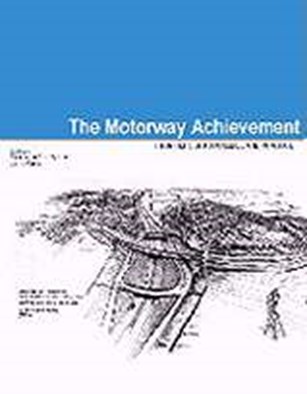
This Volume has now been published. An Adobe Acrobat copy of the publicity "flyer" can be seen here. Motorway Achievement.
The following description appears on the back cover of the volume:
"The creation of the UK motorway network in the second half of the twentieth century led to a dramatic improvement in personal mobility and underpinned sustained growth in the economy. Research carried out at TRL and elsewhere made a major contribution to this achievement.
In 'Frontiers of knowledge and practice', the first of three volumes to be published by the Motorway Archive Trust, the editors have drawn on contributions from eminent participants in the motorway programme to provide a set of first-hand accounts of the problems encountered and the steady improvement achieved through incorporation of research and feedback from practice into Department of Transport standards and specifications. The result is a wide-ranging and lively account of the role of research in the creation of the motorway network, from early beginnings in the 1950s when the quality of construction and durability were major considerations to the present day when congestion and adverse socio-environmental effects present the greatest challenges."
A resume of the various chapters in this publication can be viewed here: Frontiers of knowledge and practice
The cost of the volume is £85.00, orders can be placed with Thomas Telford directly. The Thomas Telford Customer Services Department can be contacted by 'phone on +44(0)20 7665 2464, by fax on +44(0)20 7665 2245, by email on orders@thomastelford.com, or via their website.
See the Thomas Telford website
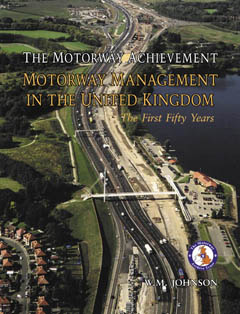
Volume 4: UK Motorway Management - The First Fifty Years (ISBN: 978-1-86077-588-8)
This Volume, written by Bill Johnson, was published in December 2008, by Phillimore and Co Ltd, to coincide with the 50th anniversary of the opening of the Preston By-pass - Britain's first motorway. The cost of the book is £25.
The following description appears on the back cover of the volume: "Since the opening of the Preston By-pass in December 1958, Britain's motorway system has grown steadily. In 2006, the Government put the network's replacement value at £65 Billion. The motorways are essential to our economy and bear about half the nation's articulated lorry mileage, but make up less than one percent of the national road system. The strain placed on the management and maintenance of the UK's motorways is the subject of this provocative new book, which examines just how such heavy usage is possible today whilst looking at challenges yet to be faced.
Bill Johnson's own extensive experience of road construction and maintenance is combined with that of other engineers throughout the UK to examine precisely how motorway building and preservation has been adapted and improved. The lessons learned will benefit all those engaged in the business of roads, from the civil servants and politicians who approve new schemes to the police whose efforts to keep the motorways safe are never-ending. But it is engineers in particular to whom this will appeal. The maintenance topics covered include lighting and safety fences, snow clearing and the removal of dangerous obstructions. The sections on the management of busy roads will intrigue all motorway users. They include the optimisation of road space through the use of speed limits that change depending on the volume of traffic, and ramp metering, which allows vehicles through junctions only when gaps in moving traffic permit. The topical issue of road pricing is discussed and the ways in which the Highways Agency informs users of its work is considered.
What is stressed throughout is the origin of modern engineering theory, in real-life situations and events. Only with that knowledge can the purpose of contemporary design be understood. In the author's words, 'it is incontrovertible that, if the lessons of maintenance are not learned and passed on, engineering does not progress.' And motorway engineering must progress if it is to continue handling increasing amounts of traffic as Britain's economy grows and its population expands."
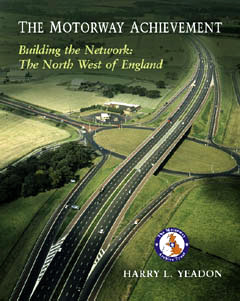
Regional Volumes: Building the network - The North West Region (ISBN: 1-86077-352-4)
This volume, written by Harry Yeadon, was published by Phillimore and Co Ltd in July 2005 and the first print run sold out. A second print run (ISBN: 13 978-1-86077-352-4) was published in December 2006. The cost remains at £20.
The following description appears on the back cover of the volume: "The north-west of England, home of the Industrial Revolution, also saw the beginning of a new era in road communications, when Britain's first motorway, the Preston Bypass section of the M6, was completed in 1958. By the end of the 20th century, the Region had a greater concentration of motorways than any other part of the country. It was realised early on that an improved road network based on a system of motorways was fundamental to the area's economic regeneration.
The North West's diverse topography and geology presented unique challenges of considerable magnitude. The engineers involved had to contend with the rugged terrain of the Pennines and the Lake District, coastal plains, and the built-up areas of major conurbations. Technical feats included crossing major rivers, the Manchester Ship Canal, other waterways and a complex railway system, in addition to the necessary provision of links to the existing road network.
This compelling and eminently readable narrative traces the Region's motorway development, outlining the benefits that have resulted in terms of traffic, safety, economy and environment. A large number of colour photographs and diagrams lavishly illustrate the author's fascinating story of what was a remarkable achievement, often carried out under difficult circumstances, of which the person concerned can be justifiably proud. Harry Yeadon's book combines landscape, regional and transport history, and highlights the numerous benefits from the motorway revolution."
Building the network - Northern Ireland (ISBN: 0-9543056-6-3)
This volume, written by T J McCormick, R R Ross, J I Bill and W McCoubrey, has been published by the Northern Ireland Roads Service. It is available only on very limited circulation and cannot be purchased.
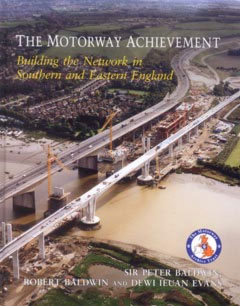
Building the network - The South East and East Regions (ISBN: 13-978-186077-44611)
This volume, written by Sir Peter & Robert Baldwin and Dewi Ieuan Evans, was published by Phillimore and Co Ltd in 2007. The cost of the book is £30.
The following description appears on the back cover of the volume: "The busy motorway network of Southern and Eastern England has, over 40 years, overlaid a vast and mostly earlier road system, adopting directly from that system only the Maidenhead and Runnymede bridges and a significant constructional experiment near Stilton in 1957-8 which now underlies the A1(M). The area’s motorways now total 657 miles – nearly one third (actually 575 miles - 27%. Webmaster) of the UK’s motorway system but by length only 0.013 per cent of all UK roads. To thread motorways around London and through the diverse economic geography and geology of those populous car-owning regions to seaports and airports, required civil engineers to overcome many planning and structural problems and the post-war shortages, particularly of steel and finance. Their work facilitated far heavier freight and passenger flows, and easier distribution for the building aggregates needed inroads, new factories and offices, New Towns and the rebuilding of London. Meanwhile, inter-urban commuting from points beyond London’s Green Belt was largely facilitated by matching investments in electrified railways – many running parallels with motorways. The book also includes the visionary ideas for motorways advanced by Lord Montagu of Beaulieu from 1906 to 1928 and the later successes of Sir Frederick Cook and Lord Watkinson of Woking in persuading H.M. Government to secure appropriate legislation and build the region’s motorways from 1958 onwards. It looks at changes in traffic control systems and envisages the extra links and motorway widening works needed to serve international trade and meet the challenges of congestion, pollution and using different fuels. This beautifully produced volume is the second in Phillimore’s Building the Network series and is sure to be highly acclaimed by transport historians."
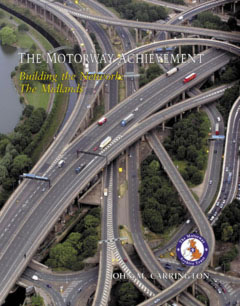
Building the network - The Midland Region (ISBN: 978-1-86077-536-9) (Includes schemes in South West Region)
his volume, written by John Carrington, was published in March 2009 by Phillimore and Co Ltd. The cost of the book is £25.
The following description appears on the back cover of the volume: "It has often been said that the Midlands is at the 'hub' of the motorway network. As the region, with Birmingham at its centre, is exactly halfway between the London and Manchester conurbations and is similarly situated between Bristol in the south-west and the rest of the country, this is, of course, a truism, but it does mean that the Midlands' importance in the nation's transport infrastructure cannot be overestimated. A population of some three million people makes the city of Birmingham the second-largest conurbation in Britain.
The first motorway to enter the area was the M1 and its associated M45 spur, which opened to traffic in 1959. The basic network was laid down around this time but remains incomplete to this day. It took a further 16 years before London and Birmingham were directly linked, with the building of the M6 Midland Links motorways, and for many years the 'hub' consisted of only three 'spokes', the M1, M6 and M5. The elevated section of 5.6 miles, including the formidable Gravelly Hill ('Spaghetti junction'), remain among the greatest design and construction achievements in the entire motorway network.
The M69 between Coventry and Leicester was planned as part of a link between industrial centres in the South West and North East and the M54 finally connected Telford New Town to the M6. The M42 connects the M5 south of Birmingham to the M1 at Nottingham and provides a national cross-country route, but the network today is the most congested in Europe, the M5, M6 and M42 all carrying double their original design capacity. The M40 was planned to provide a second link between London and Birmingham, and the first section between London and Oxford was opened in 1974, but it took a further 17 years before the motorway was finally complete. It did, however, provide the final 'spoke' to the Midlands 'hub' - 32 years after the first link, to which it brought major relief. Drawing directly on the experiences of those responsible for these significant accomplishments,'Building the network' describes the planning, design and construction of all the motorways in the eight Midland Counties."
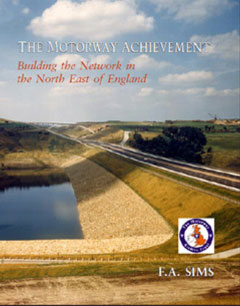
Building the network - The North East Region (ISBN: 978-1-86077-520-8)
This volume, written by Joe Sims, was published, by Phillimore and Co Ltd, in July 2009. The cost of the book is £25.
The following description appears on the back cover of the volume:
"THE NORTH EAST OF ENGLAND is one of the country’s leading industrial regions, and has been served historically by Roman roads and the ‘Great Road to the North’. In the 1930s the country’s surveyors gave a great deal of thought to the problem of Britain’s roads, and the Institution of Highway Engineers submitted plans to the Ministry of Transport, but the intervening war meant it was not until the mid-1950s that work started on the first motorways designed to link the major cities and connect with local networks. In 1957 approval was granted by the Ministry of Transport for the construction of Doncaster Bypass A1M and the great motorway era in the North East was begun. This first scheme on the Great North Road trunk route to meet motorway standards was followed by the upgrading of the entire A1 to a dual carriageway and later motorway status. This eminently readable and illustrated narrative recalls the setting up of Highways and Bridges Departments in the various counties and the prominent people who were involved at the time. The schemes for the improvement of Trunk Road A1 through the West Riding, North Riding, Durham and Northumberland are examined in detail, and the Newcastle Central Motorway East and the Western Bypass are included.
The reader is then taken on a journey of the other motorways in the region and insight is offered into their planning, design and construction. The diverse climate, topography and geology presented a considerable challenge, as did the old mine workings and legacy of mining subsidence. The many significant feats of engineering covered here range from overcoming the hazards of crossing the Pennines and the glacial silt lakes of Durham to routing a motorway on a two-level structure through Sheffield. The River Humber was crossed on a record-breaking suspension bridge, but the crossing of other major rivers, railways and canals featured in many schemes. Times of great drama are remembered, such as the trauma over Tinsley Viaduct and the failure during the construction of the Calder Bridge. The effects of major changes in the administration of highway works are also considered, including the creation of Road Construction Units and their eventual demise, the reorganisation of local government, the greater involvement of engineering consultancies and procurement of schemes through the Private Finance Initiative.
This history is mostly a story of success achieved through tremendous endeavour and goodwill. The motorways in the North East have made an enormous contribution to the prosperity of today’s region and those involved can feel justly proud. This fascinating book is by way of tribute to them."
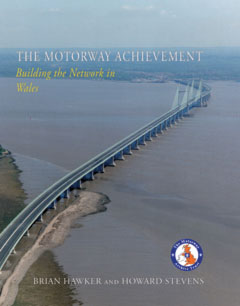
Building the network - Wales
This volume, written by Brian Hawker Ron Bridle and Howard Stevens, has been published by Phillimore and Co Ltd.
The following description appears on the back cover of the volume: "Wales has less than 100 of the 2,000 miles of motorway constructed in Britain in the 20th century. However, the Principality can boast the first length of urban motorway, the first motorway tunnels, the longest rock tunnels, the first immersed tube tunnel, and major estuarial bridge crossings.
Wales is a land of mountains and valleys. The topography provides major engineering challenges requiring high-cost solutions. Viaducts, bridges, tunnels, and major earthworks play an integral and prominent part. The need to bypass communities located in narrow valleys and environmentally sensitive areas confronted road designers with conditions unique in the UK. Following an introductory chapter, this book describes the background, formulation and implementation of the major roads strategy and comments on the management of the built asset.
The commentary in the concluding chapter reviews the past, the present and the future. The overcoming of the engineering challenges and the successful completion of 80 miles of motorway in South Wales and 88 miles of near motorway- standard dual-carriageway in North Wales is celebrated in this book, which will appeal to all those with an interest in our civil engineering heritage. "
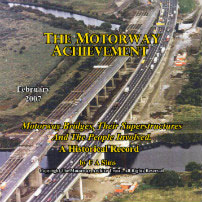
The Motorway Achievement: Motorway Bridges, their Superstructures and the People Involved. A Historical Record
The Archive covering bridge superstructures comprises documents and papers from
the following sources:
− Extracts from Regional Archives.
− Personal contributions from those engineers, mostly retired, who have agreed
to participate.
− Published books and papers
− Department of Transport documents
− The writer’s personal archive.
− Slides and photographs.
See here: THE MOTORWAY ACHIEVEMENT MOTORWAY BRIDGES, THEIR SUPERSTRUCTURES AND THE PEOPLE INVOLVED
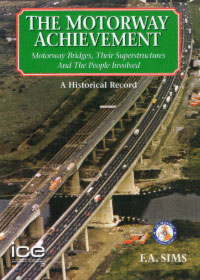
OTHER RELEVANT PUBLICATIONS
Available only in CD format. Contact Mike Chrimes at Mike.Chrimes@ice.org.uk for details.
Written by F A (Joe) Sims, the text on the back of the CD says: Joe (F.A) Sims took on the role of researching and putting together the Motorway Bridge Story. It is one for which he is eminently qualified having been personally involved with bridges throughout his career and with many of the key developments.
This CD provides a comprehensive history of bridge engineering in the post-War period. Brief descriptions are given of many of the important bridges and the design and construction problems encountered. Developments in analysis, new materials and techniques, and the organisation of research and the construction industry are all covered. The role of major clients like the Ministry of Transport, and specialist organisations and research bodies, including universities and colleges, are explored. Some of these organisations have so changed that the significance of their role can only be understood by reference to this work - the Cement and Concrete Association being the most obvious example. Thorough referencing enables the researcher to follow up any area of interest within the civil and structural engineering fields covered. The names of prominent people involved during this significant and exciting time for British engineering are recorded.
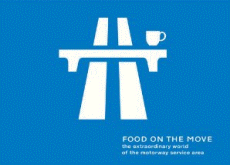
Food on the Move (the extraordinary world of the motorway service area)
Although not one of the Motorway Archive Trust's Publications, this book, written by David Lawrence and others, presents extremely comprehensive coverage of the history and development of the 70 odd Motorway Service areas which have been provided in parallel with the development of the Motorway system.
The following comment, by Will Self, appears on the back cover of the volume: The motorway service area is an integral part of every Briton's experience: our willed ignorance of them mirrors our wider denial of the extent to which vehicular transport dominates our perception of our land. At last, comes a writer who is capable of rectifying this Wimpy-shaped zone of ignorance and bringing it to startling and poetic life...
Amazon
All of the above available publications can also be acquired from the Amazon website. Enter "motorway achievement" in the search box. The books published by Phillimore and Co Ltd can be acquired directly from their website at a 10% discount